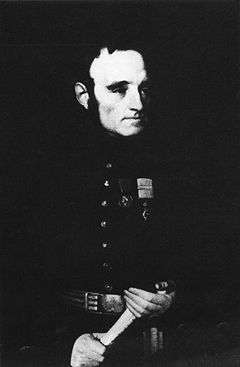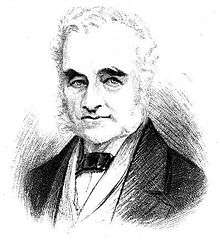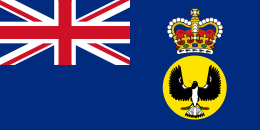George Gawler
| Lieutenant Colonel George Gawler KH | |
|---|---|
 | |
| 2nd Governor of South Australia | |
|
In office 17 October 1838 – 15 May 1841 | |
| Preceded by | John Hindmarsh |
| Succeeded by | George Grey |
| Personal details | |
| Born | 21 July 1795 |
| Died |
7 May 1869 (aged 73) Southsea |
| Resting place | Portsmouth |
| Spouse(s) | Maria |
| Occupation | Army officer, Colonial administrator |
| Awards | Knight of the Royal Guelphic Order |
| Military service | |
| Allegiance |
Great Britain (1795–1801) United Kingdom (1801–1846) |
| Service/branch |
|
Lieutenant-Colonel George Gawler, KH, (21 July 1795 – 7 May 1869) was the second governor of South Australia; from 17 October 1838 until 15 May 1841.
Biography
Gawler was the only child of Captain Samuel Gawler, captain in the 73rd Regiment of Foot, and his wife Julia, née Russell. Gawler's father was killed in battle in Mysore, India in December 1804. The Gawler family historically came from Devon. George Gawler was educated by a tutor, then at a school in Cold Bath, Islington.[1] Two years were then spent at the Royal Military College, Great Marlow, where he was a diligent and clever student.
In October 1810 Gawler obtained a commission as an ensign in the 52nd (Oxfordshire) Regiment of Foot and in January 1812 went to the Peninsular War. He was a member of a storming party at Badajoz, and was wounded and saved from death by a soldier who lost his own life. He was in Spain until 1814, taking part in the advance on Madrid. The regiment returned to England and Gawler, now a lieutenant, fought at the Battle of Waterloo. He remained in France with the army of occupation until 1818, and in 1820 married Maria Cox of Friar Gate, Derby who was the niece of Samuel Richardson.[1] Gawler's new sister-in-law, Mary Ann, married William Leeke, a fellow officer from the 52nd. Gawler and his wife were sincerely religious and when the 52nd was sent to New Brunswick in 1823 they did much social and religious work. Gawler returned to England in 1826 and from 1830 to 1832 was engaged in recruiting. He reached the rank of lieutenant-colonel in 1834 and in 1837 received the Royal Hanoverian Guelphic Order (KH), third class.
In 1838 Gawler was appointed governor of South Australia in succession to Captain John Hindmarsh, who had been recalled. Gawler and his wife and children arrived on the Pestonjee Bomanjee on 12 October 1838, after a four-month journey via Tenerife and Rio de Janeiro.[2] Gawler found the colony had almost no public finances, underpaid officials and 4000 immigrants living in makeshift accommodation. He was allowed a maximum of £12,000 expenditure a year, with an additional £5,000 credit for emergencies.
His first goal was to address delays over rural settlement and primary production. He persuaded Charles Sturt to come from New South Wales to work as surveyor-general, personally overseeing the surveys in the meantime, as Colonel William Light had resigned due to ailing health and the demands placed on him with insufficient staff. Gawler promptly increased and reorganized the fledgling police force, promoting its commander Henry Inman. Gawler appointed more colonial officials, took part in exploration, and improved the facilities at Port Adelaide during his tenure as governor. The first permanent Government House was built, which is now the East Wing of the present building.
Due to droughts in other Australian colonies in 1840, before South Australia was self-sufficient in food, the cost of living increased rapidly. Gawler increased public expenditure to stave off collapse, which resulted in bankruptcy and changes to the way the colony was run. Over £200,000 had been spent and the land fund in London had been exhausted. A £155,000 loan was approved by the British Parliament (later made a gift) and Captain George Grey was sent to replace Gawler, after Grey promised to "maintain the strictest economy".[3] In his time in office Governor Gawler had managed to make South Australia self-sufficient in terms of agriculture and had restored public confidence.
Gawler's work was long misjudged, largely because his successor Grey, in his dispatches, made the worst of his predecessor's acts, without suggesting the difficulties under which he had worked.[3] Gawler was a gallant and energetic officer who, when he found the settlers faced with disaster, saw at once what it was necessary to do, and saved the colony. However, although in his Colonization of Australia Mills accepts the view that Gawler had been guilty of carelessness and extravagance and cannot be wholly acquitted of blame, the extraordinary difficulties with which he was faced are acknowledged. Charles Sturt and other men at the time generally agreed that his administration had greatly benefited the settlement, and the select committee on South Australia reported that the critics of his expenditure were "unable to point out any specific item by which it could have been considerably reduced without great public inconvenience". Gawler was recalled, but later investigations show him among the founders of South Australia.
Legacy

In 1845, Gawler wrote a book in which he suggested that Jews be allowed to establish Jewish agricultural settlements in Palestine as compensation for their suffering in Europe and under Turkish rule. In 1849 he toured Palestine with Moses Montefiore.[4] Two years later (in 1852), he established an association for the colonization of Palestine. Gawler died in Southsea and was buried in Portsmouth. One of his grandsons, Douglas Gawler, was a member of parliament in Western Australia.
The town of Gawler was named after him, as it was surveyed soon after he arrived. The Gawler Ranges at the north end of Eyre Peninsula are also named after him. Derby's Town and County Museum in the 1830s included Gawler in its list of principal benefactors. Gawler had contributed a collection of minerals and exotic stuffed birds which included an albatross from his time as governor.[5] In addition Gawler's gardener, Joseph Whittaker, in Australia contributed hundreds of pressed flowers and plants to Derby Museum and to Kew Gardens.[6]
References
- 1 2 Serle, Percival (1949). "Gawler, George". Dictionary of Australian Biography. Sydney: Angus and Robertson. Retrieved 28 March 2011.
- ↑ "The Pestonjee Bomanjee 1838". South Australian Register. 13 October 1838. Retrieved 30 November 2010.
- 1 2 'Grey, Sir George (1812–1898)', Australian Dictionary of Biography, National Centre of Biography, Australian National University, http://adb.anu.edu.au/biography/grey-sir-george-2125/text2691, accessed 23 January 2012.
- ↑ Green, Abigail (2010). Moses Montefiore: Jewish liberator, imperial hero p231. Harvard University. p. 540.
- ↑ Glover, Stephen (1829). The history and directory of the borough of Derby, a guide. p. 58.
- ↑ Kraehenbuehl, DN; Moyes, N (1999). "Joseph Whittaker: early English botanical visitor to South Australia". South Australian Naturalist. 73 (3–4): 44–60.
External links
- "Government House". Governor of South Australia. Retrieved 23 June 2011.
- "Memorials and Monuments in St Simon's Church (Colonel George Gawler KH)". Retrieved 23 June 2011. – Memorials and Monuments in Portsmouth, Hampshire, UK
- R. Hetherington (1966). "Gawler, George (1795–1869)". Australian Dictionary of Biography. 1. MUP. pp. 431–435. Retrieved 23 June 2011.
| Government offices | ||
|---|---|---|
| Preceded by Captain John Hindmarsh, KH, RN |
Governor of South Australia 1838–1841 |
Succeeded by Sir George Edward Grey KCB |

